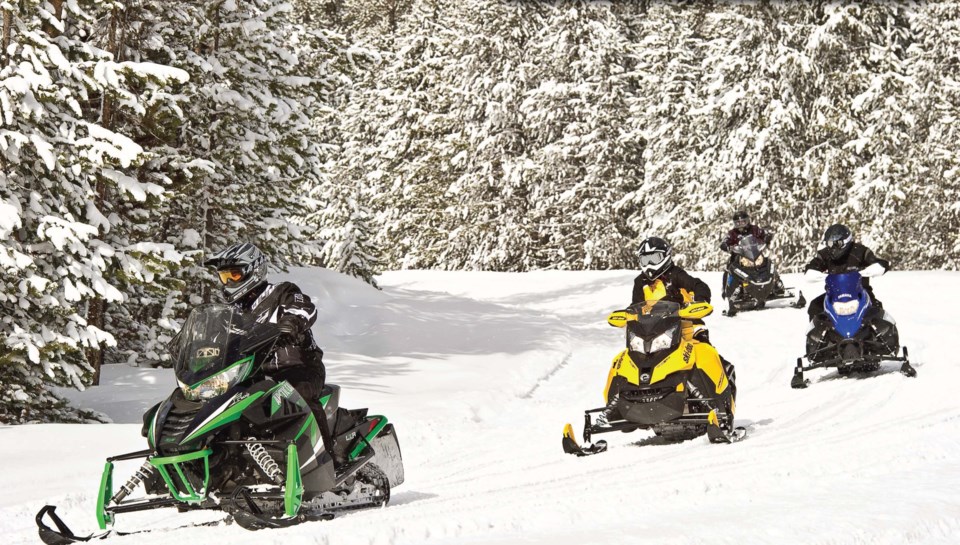January is the prime month for Saskatchewan snowmobilers to get their machines out and enjoy the trails all across the province, which is why it's also the perfect time to talk about snowmobile safety.
This year, the provincial government declared Jan. 17-23 to be Snowmobile Safety Week, to help promote the popular winter sport and educate riders on how to stay safe.
In the spirit of the campaign, the Saskatchewan Snowmobile Association has been sharing important-to-know tidbits about snowmobiling all week, including tips about safety, legislation and fines and COVID-19 safety.
“It is a great opportunity to promote safe and enjoyable snowmobiling that encourages all snowmobilers to take advantage of snowmobile safety programs,” said Sask Snow executive director Leah Switzer, in an email with the Moose Jaw Express.
Although the dedicated awareness campaign is almost over, the experts say the following tips are always important to remember, for both new and experienced riders alike.
Before even thinking about hitting the trails, Switzer reminded riders that all snowmobiles have to be registered, and any rider born on or later than Jan. 1, 1989 must complete their snowmobile safety certificate to legally operate a machine. The course itself is currently available online from Sask Snow.
It's also important to be properly prepared before taking off, and that includes more than just wearing appropriate attire and keeping machines properly maintained.
Switzer recommends riders suit up in a properly fitting helmet and gear, and carry some emergency supplies: a tow rope, first aid kit and extra maintenance items like spark plugs, an extra snowmobile belt and, if riding at night, extra headlight bulbs.
She also noted some other universal rules of snowmobiling that are always in play. For starters, snowmobilers should never ride alone, or use alcohol or drugs when operating a machine, either before or during snowmobiling.
Riders should always operate at a safe speed, and drive within the limits of both the machine and their own ability. They should always inform someone of where they’re planning to go and when they’ll be back, in case of emergencies.
It’s important to know the hand signals and use them when out on the trails, said Switzer, and to stay safe when travelling in low-visibility conditions or over familiar bodies of water.
This year, she added, using caution around water is especially important as the weather has kept some lakes, rivers and sloughs from freezing properly, which means they’re unsafe to travel over.
In addition to safety tips, Sask Snow also shared some advice that has more to do with etiquette than safety.
There are plenty of groomed snowmobile trails available all over Saskatchewan, many of them maintained by clubs within the local area who work with landowner to obtain permissions.
Switzer says that it's extra important to know where snowmobiling is allowed, because riding on private land without permission can be considered trespassing and can result in fines.
“If you are in an area without snowmobile trails, do not enter posted land,” said Switzer. “If you don’t know, don’t go. It is important for snowmobilers to take responsibility when out on the trails, to set a good example, and continue to educate everyone in the sport from an experienced rider to a beginner on how to enjoy themselves, safely, legally, and responsibly.
Sask Snow keeps an interactive map of the trail system in the province, as well as a Sask Snowmobile Trails app to help riders find shelters, guage trail distances, and check for grooming updates or weather warnings.
Local clubs may also have trail maps available, and SGI can provide a provincial trail map to snowmobilers when they register their machine.
It's also good snowmobiling practice to avoid excessive speed and noise, and to respect the land wherever you ride. This means respecting wildlife, following signage and the rules of the road, and making sure to take litter with you when you head out — or, as Switzer explained it, “pack it in, pack it out.”
COVID-19 is also having an effect on snowmobiling this year, said Switzer. Although the sport is a safe, socially distanced activity for the whole family, riders should still be following public health regulations including restrictions on gathering sizes and household contact.
She recommends riders carry a face mask and hand sanitizer with them on the trails, to use when stopping at trail shelters. It's also recommended to keep a two-metre distance when stopping at shelters and to avoid gathering with riders from outside your household.
It may seem like a lot to remember for those new to snowmobiling, but Sask Snow encourages riders to follow these rules and advice to keep the sport as fun and safe as possible.
“Through their actions and the examples they provide, they can help preserve and enhance the family sport of snowmobiling,” said Switzer.
For more information about snowmobiling in the province, visit sasksnow.com or call the organization’s main office at 1 (306) 729-3500.




